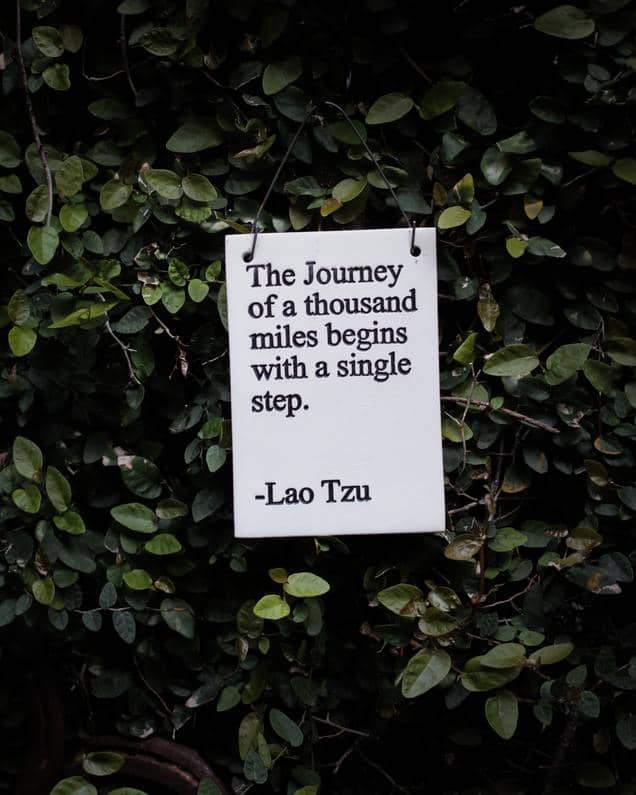
Have you ever thought you set a realistic fitness goal for the year and then failed to stick with it for more than a month or two at the most? If you did, you’re obviously not alone! Over 73% of Americans are now either overweight or obese. This shows that most people aren’t sticking with their fitness goals for long.
According to the CDC, only about 23% of people over the age of 18 meet the physical activity guidelines for both cardio and strength training exercises. And those guidelines are considered minimums! They suggest doing cardio for 30 minutes at least 5 days a week and strength training 2 days a week.
Getting fit seems to be a problem for most people and this is the time of year when we’re more focused on it. So I want to give you some guidelines on how to set a realistic fitness goal for this year so you’re able to commit to it for good.
What’s your main fitness goal
Obviously, you need to start by deciding on your main long-term fitness goal. What are you hoping to achieve? Do you want to lose weight? Do you want to build muscle to get toned? Do you want to train to run a marathon this summer?
Make sure it’s something that’s meaningful for you and will improve your life. You really want to think about why it even matters to you. If it’s weight loss, write down all the ways your life will be better after you lose it. What will you be able to do once you reach your goal other than just fitting into a smaller pant size?
Just choose one goal to focus on. Once you reach that goal you can move on to another. Choosing just one will help you be hyper-focused on that and less distracted with other things. We live in a world of too many distractions so when it comes to goal setting, it’s better to keep it simple.
Make it a SMART goal
A huge part of setting a realistic fitness goal is turning it into a “SMART” goal. That’s an acronym that stands for:
Specific. Which means exactly that. What exactly do you want to achieve? For example, how much weight do you want to lose? What size do you want to be?
Measurable means you need to be able to measure it. Weight is an easy measurement to track over time. But you could also literally measure areas of your body (waist, arms, legs, etc.) with a flexible tape measure to track improvements.
Attainable means your goal should actually be possible. So losing 100 lbs this year is technically attainable but it’s pretty lofty! You would have to consistently lose about 2 lbs every week. You could do it but it’ll require never having a bad week! And that’s pretty tough. You want this goal to be sustainable which leads to…
Realistic/Relevant meaning focusing on one thing at a time and being realistic about what you’re willing to do and not do. Relevant refers to a goal that has meaning for you and your life, not everyone else’s life. Do it for you and in a way that you can manage given your current circumstances.
And last but not least, a goal should be timebound. In other words, you need an end date for your fitness goal. We all know we don’t do well without deadlines, so make one!
Here’s the simplest example of a SMART goal.
“I want to lose 25 lbs by the end of June”
Start with the end in mind and break it down
So going with that example, let’s say it’s the beginning of January and you have till the end of June to reach your goal. Now break that down into smaller monthly and weekly goals that are more manageable. You’ll need to lose about 4 lbs each month to reach your goal which is only one pound a week. Easy!
According to every authority, a healthy and sustainable weight loss is about 1-2 lbs a week. And remember that you may not lose exactly that much every week. Progress is rarely that linear. You’ll have ups and downs but over time (if you’re consistent) things should average out.
But an average of 1 lb a week is a very realistic fitness goal. And although you may know where you want to end up, you also need a plan for how to get there. And that doesn’t mean jumping in all at once and burning yourself out before the first month ends.
Create mini-goals
So once you’ve got your main fitness goal stated, you need to figure out how to get here. Mini-goals are the little things you plan to do each week, or month, that will inch you closer to that end goal.
First, come up with a form of exercise you enjoy. This is really important! If you don’t like it, you won’t stick to it. So if you need to try something new every week to figure it out then do that. Too many people take up exercise they don’t like as if it’s punishment. Don’t do that to yourself! It shouldn’t be dreaded.
Then, be realistic about the amount of time you’re willing to devote to it each day. So don’t start with where you want to end up for exercise! Ease into this new habit. The point is to start easy to make it a habit first then work your way up in intensity and time.
Finally, it would be smart to come up with one simple dietary change you could make to cut out some extra calories every day. Combining both exercise and a calorie deficit will help you achieve your weight-loss goal much more quickly. An example would be to stop snacking. I did this recently and lost some weight I had started to gain. One small change can make a big difference!
Related article: Can you lose weight with exercise alone?
Set a simple fitness goal
If you haven’t been exercising at all then start with something simple like walking and commit to just 10 minutes at a time. If you can, do that twice a day. Then every two weeks add 5 more minutes to one of those sessions. Eventually, you can try to combine those into just one 30-45 min session. Unless you like doing it twice a day! It’s up to you.
Remember that the minimum recommendation for cardio is 30 minutes a day on at least 5 days a week. Research by The Nat’l Weight Control Registry has found that 90% of people that lose weight and keep it off exercise for about an hour every day. But if you start at that level, I guarantee you’ll burn yourself out!
When I first got my elliptical machine I started with just 5 minutes at a time! I slowly worked up to 30 minutes over a period of months. And that’s still a part of my regular workout! Make it more interesting by listening to or watching something you like while you exercise. That way you won’t get bored so easily!
Schedule your exercise
Your goal at this point is just to create a new habit of daily exercise. So schedule the exercise into your day. Be sure that everyone around you knows what time or times of day you’ll be doing it! Your success is dependent on your loved ones respecting and supporting the time you’re taking for your health.
According to James Clear, author of the amazingly helpful book “Atomic Habits“, you need to clarify when, where and how you’re going to do something. So make a specific plan, announce it, put it on your calendar, then follow through. Motivation builds once it becomes a habit and you start seeing results.
I highly recommend his book for strategies on changing habits. Get it in audio form and you can listen to it while you work out!
Write it down
Once you’ve decided on realistic mini-goals and your schedule for progressing, write your plan on a calendar so you remember what you should be doing. Then be sure to write down what you actually do every day. This will help you stick to your goals and see your real progress. It gives you some accountability.
I still write down my workouts on a calendar. It helps me to see what I’ve been doing and when so I can keep track and be more consistent.
Create a calorie deficit
I already mentioned coming up with a dietary change. A great mini-goal for weight loss would be to find something in your diet that you can give up or cut back on. Years ago I gave up soda which created a deficit of about 150 calories every day. And surprisingly, it wasn’t that hard!
Remember: This doesn’t mean you can never indulge in it again, it just means it’ll be a rare treat. Just be realistic about what you’re willing to cut back on.
If you can cut out just 150 calories a day that will make reaching a weight-loss goal much easier when it comes to exercise. It takes a lot more exercise than you think to burn calories! And you probably won’t want to exercise that hard in the beginning. None of my personal training clients ever did!
The key to eliminating something is to make sure you know what you’ll replace it with. Maybe flavored carbonated water instead of soda? You could make your own fruit-flavored water. I’ve found some amazing teas out there too.
Read my blog “What to drink (and not drink) for better health” to get more ideas.
You could also drop one of your high-calorie, unhealthy treats and replace it with a new fruit every week to give yourself a boost of nutrients and some fiber. If you start reading labels you’ll quickly figure out where all the extra unnecessary calories are coming from.
Again, don’t try to change everything. Just find one thing that will make a difference and get used to that. Then change another thing later on. Baby steps make success much easier to achieve!
Plan ahead for obstacles
You may have a very realistic fitness goal but if you don’t plan ahead for obstacles then you’re making life harder! Part of my job as a health coach is to help people identify possible barriers on their health journey and plan ahead for how to deal with them. That way you’re not caught off guard.
When it comes to being healthy, planning is everything!
For example, if you take a vacation will you be exercising every day and watching your calories? Most people don’t. What if you’re entertaining company for a while? Do you have ways to exercise both indoors and out? What if you’re sick for a week, or three?! How will you handle these situations?
All of these examples will mess up your regular routine and make exercise and healthy eating harder. And as soon as you get out of a habit, even for a week, it’s hard to get back into it. So think ahead and make a plan.
If you’re having company for a week, tell them before they arrive what your routine is so they know to work around it. If you’re going on a beach vacation plan to take a walk after every meal, or once in the morning and once in the evening. Or take an exercise class every day at the resort.
You will inevitably fail in some situations, but when that happens just learn from it and get back on track as soon as possible. That way you can make a better plan for the next time. One failure doesn’t mean you scrap the whole process. Imagine if we did that in all areas of our lives! We wouldn’t accomplish much.
Visualize reaching your fitness goal
The last thing I want you to do every day is to visualize reaching your goal and what it will be like once you do. This only takes a couple of minutes a day but you can do it more often if you want to.
While you’re drinking your morning coffee just take a couple of minutes to meditate on what your life will be like once you reach your goal. How will it be different and how will you feel differently?
According to this video from Mel Robbins, your brain doesn’t know the difference between something you imagine and your actual experiences. Practicing visualization will help you to build skills.
My final thoughts
If you want to set a realistic fitness goal that you can commit to for the long term then follow my guidelines.
-
- Pick one main goal to focus on that has meaning for your life.
- Make it a SMART goal.
- Break it down and create mini-goals that are more manageable for you.
- Start small with exercise and work your way up to where you want to be.
- Create a calorie deficit by cutting out or cutting down on an unhealthy item in your diet.
- Write down your mini-goals on a calendar and schedule progressions.
- Think about obstacles you might encounter and plan ahead for them.
- Visualize reaching your fitness goal every day
Doing these things will help you set a better fitness goal, follow through, and actually reach that goal when you hope to. But I know it can still be hard on your own. So if you need some extra help, please contact me for personal training (in my area) or health coaching (online) for more assistance.
If there’s anything I’ve missed or you have a specific question for me about how to set a realistic fitness goal this year then comment below and I’ll get back to you. I would also love to hear about fitness goals you’ve reached in the past and how you did it!


Thanks for the great article!
You’re welcome! I’m glad you found it helpful!